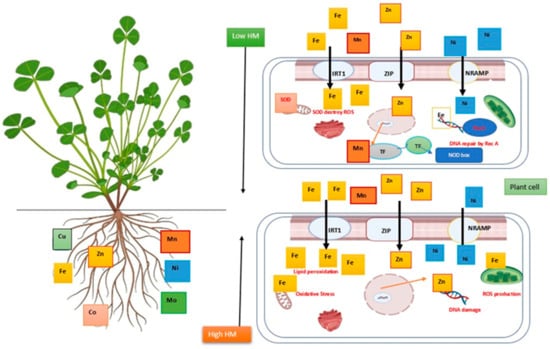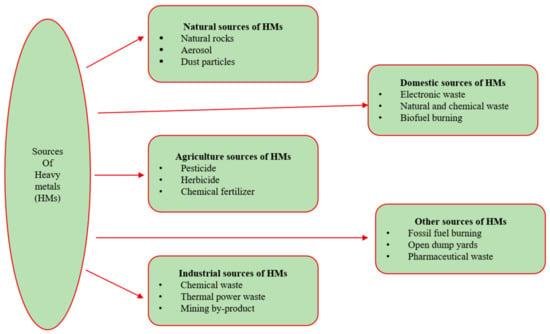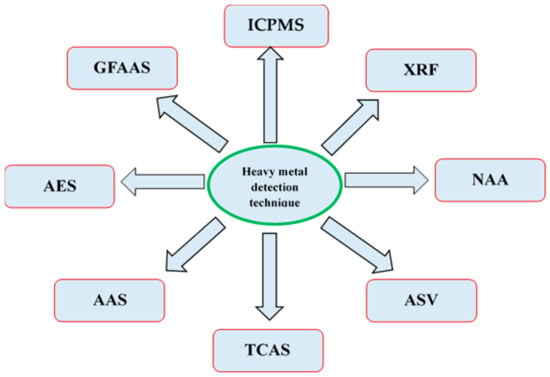You're using an outdated browser. Please upgrade to a modern browser for the best experience.
Please note this is a comparison between Version 1 by Vishnu D. Rajput and Version 2 by Camila Xu.
It is possible for heavy metals (HMs) to be present in pharmaceutical herb materials coming from anthropogenic activities like agriculture, industrial waste, and natural sources. In various ethnic groups, there is evidence that contaminants were purposefully added in the belief that they had some sort of therapeutic benefit. HM toxicity of medicinal plant products has been linked to a wide range of adverse health effects, causing dysfunction of the liver, kidney, and heart, and even death.
- heavy metals (HMs)
- herbal plants
- atomic absorption spectroscopy
- X-ray florescence
1. Heavy Metals, Medicinal Herbs, and Regulatory Documents
The common heavy metals (HMs) in the environment are lead, cadmium, and mercury, and their major sources are vehicles, industrial and thermal power plants, waste incinerators, and agricultural production [1][2][3][4][11,12,13,14]. Plants, especially trees, act as a barrier to the spread of HMs. A comparative analysis of approaches to regulation of HMs in medicinal plant materials and herbal medicinal products adopted in Russia, Europe, the United States, and Asian countries were carried out. For this purpose, the current editions of the Russian, European, American, and Asian pharmacopoeias, as well as international standards, have been studied (Table 1).
Table 1.
Permissible concentrations of heavy metals according to regulatory documents in different countries.
| Food Items and Medicinal Plant Materials | Regulatory Document | Permissible Concentrations (mg/kg) | |||
|---|---|---|---|---|---|
| Pb | Cd | Hg | As | ||
| Medicinal plant materials and herbal medicinal products |
Russian pharmacopoeia [5][15] | 6.0 | 1.0 | 0.1 | 0.5 (Laminaria 90) |
| Herbal medicines, medicinal herbs |
European pharmacopoeia [6][16] | 5.0 | 1.0 | 0.1 | There are no general regulations (Laminaria 90) |
| Herbal medicines | United States pharmacopeia [7][17] | 5.0 | 0.5 | 1.0 (total) methyl mercury 0.2 |
Non-organic 2.0 |
| Medicinal plant materials and herbal medicinal products | Eurasian Economic Union pharmacopeia [8][9][18,19] | 6.0 | 1.0 | 0.1 | 0.5 |
| Medicinal plant materials (underground organs) | Pharmacopoeia of the People’s Republic of China [10][20] | 5.0 | 0.3 | 0.2 | 2.0 |
| Herbs consumed by humans | World Health Organization [11][21] | 10.0 | 0.3 | – | 1.0 |
| Traditional Chinese herbal medicines | ISO international standards [12][7] | 10.0 | 2.0 | 3.0 | 4.0 |
| Medicinal herbal preparations | Ayurvedic pharmacopoeia [13][22] | 10.0 | 0.3 | 1.0 | 3.0 |
| Medicinal herbal preparations | Thai pharmacopoeia [12][7] | 10.0 | 0.3 | – | 4.0 |
| Medicinal plant materials | Korean pharmacopoeia [12][7] | 5.0 | 0.3 | 0.2 | 3.0 |
| Traditional medicine products | Singapore Health Sciences Authority [14][23] | 20.0 | – | 0.5 | 5.0 |
According to the current State Pharmacopoeia of the Russian Federation (14th edition), the content of lead in medicinal plant materials and herbal medicinal products should not exceed 6.0 mg/kg; for cadmium—1.0 mg/kg; for mercury—0.1 mg/kg; and for arsenic—0.5 mg/kg [5][15]. The content limits of HMs in medicinal plant materials are similar to those for dry herbal dietary supplements and are less stringent than similar requirements for fruits, berries, and drinks (Table 1). A comparative analysis of the regulatory documentation in various countries has found that the requirements for the environmental safety of medicinal plant materials and herbal medicinal products differ significantly.
The Russian standard for lead is lower than that recommended by World Health Organization and the International Organization for Standardization (ISO) (10 mg/kg). Nevertheless, it is slightly higher than the corresponding standard set by the European, American, and Chinese pharmacopoeias (5 mg/kg). For cadmium, the standard established by the Russian pharmacopoeia is similar to the European one and is more than three times higher than those recommended by WHO and many Asian countries (0.3 mg/kg). Interestingly, in the recent edition (2020) of the Chinese pharmacopoeia, the maximum permissible concentration (MPC) for cadmium was changed from 0.3 mg/kg to 1.0 mg/kg [12][14][7,23].
This is an illustrative example of a trade-off between safety for human health and the need to use medicinal herbs that grow in a particular region.
The WHO, Russia, and a number of countries have similar requirements for mercury concentration; however, in the Chinese and Indian pharmacopoeias, the MPC is 10 times higher, while the American pharmacopoeia separately regulates the content of methylmercury. The Russian pharmacopoeia imposes the most stringent requirements for arsenic concentrations; the regulatory documents of other countries set standards that exceed the Russian ones by 2–8 times. When comparing the methods for analyzing medicinal plant materials for HMs, it has been revealed that they do not always correspond to each other, which may explain the difference in maximum permissible concentration (MPC) values. Thus, in foreign pharmacopoeias, the arsenic concentration in medicinal plant materials and herbal medicinal products is determined by decomposition in closed vessels, which eliminates the loss of the element at the stage of sample preparation.
There are a number of imperfections in the methods for determining HMs given in the current State Pharmacopoeia of the Russian Federation [5][15]. The incorrectness of using standard samples to analyze medicinal plant materials and herbal medicinal products, in which HMs are found the form of inorganic salts and are not associated with organic compounds, was noted [15][24]. According to the researchers, it is advisable to use standard samples of plant materials certified for the content of HMs, as the organic matrix has a significant influence on measurement results. In addition to the listed metals, the concentration of copper is regulated in China and Singapore, and the content of nickel is regulated in European countries. The introduction of MPCs for these metals, as well as zinc, iron, and manganese, possibly taking into account the regional characteristics of industrial activities, is also a pressing issue in Russian Federation. Another aspect to consider is the part of the plant used in pharmacy. The State Pharmacopoeia of the Russian Federation [5][15] imposes uniform requirements on the content of toxicants for all types of plant materials. In the Chinese pharmacopoeia [10][20], the standards for HM contents in underground organs are set separately, which is logical, because when growing on polluted soil, many species are able to limit the supply of xenobiotics to the aerial part, especially to the generative organs.
There is large number of publications that analyzes the regional features of HMs’ accumulation in medicinal herbs [15][16][17][18][19][20][21][22][23][24][6,24,25,26,27,28,29,30,31,32]. For example, the environmental purity of Cichorium intybus L. in the Trans-Ural region of the Republic of Bashkortostan (Russia) has been assessed according to the MPCs of chemical elements in feed for farm animals and feed additives (5 mg/kg Pb, 0.3 mg/kg Cd) [23][31]. The researchers have concluded that it is inappropriate to harvest the raw material under study as a medicinal plant material due to the excess of cadmium concentration by 3.0–6.5 times. However, by the current MPC for medicinal plant materials safety assessment, the results would have been different. Although the content of HMs in plants depends on the intensity of contamination in the harvesting area, a general conclusion about the unfavorable environmental situation is not enough to assess the possibility of growing medicinal herbs in a particular area. The safety of 51 samples of Tanacetum vulgare L. flowers, harvested in urban and agroecosystems of the Voronezh region, was established with respect to the content of HMs and arsenic [16][6]. The roots of Taraxacum officinale F.H. Wigg. plants growing in the Voronezh region near roads and railways were also found to be safe, while in the samples collected near a thermal power plant and a chemical enterprise, an excess of arsenic was recorded [16][6]. The aboveground parts of Artemisia frigida Willd. and Artemisia jacutica Drob. growing in the Republic of Buryatia, as well as A. frigida growing in Mongolia, had lead and cadmium concentrations within the normal range (except for the year in which forest fires occurred) [25][33]. It was found that Plantago major L. leaves harvested in the park area of the central part of the city of Kursk (Russia) were environmentally safe, while in the industrial area the concentration of lead in these medicinal plant materials was 20.5 times the MPC [26][34]. The content of HMs in medicinal plant materials growing in the Grodno region (in the Republic of Belarus) did not exceed the MPC [21][29]. This applied to both wild (Vaccinium vitis-idaea L., Vaccinium myrtillus L., Elytrigia repens (L.) Nevski, Artemisia absinthium L., Hypericum maculatum Crantz, Angelica sylvestris L.) and cultivated (Calendula officinalis L., Chamomilla recutita (L.) Rauschert, Aesculus hippocastanum L., Paeonia anomala L.) plants.
2. Impact of Heavy Metal on Herbal Plants
Soils have become a significant source of HM pollution and possess a high conversion of ion capability. Certain important HMs become crucial elements which are required in extremely low quantities for proper development of plant [27][43]. Such HMs play a lead role in physiochemical processes in plants. Plant roots absorbs HMs from soil by the phenomenon of diffusion [28][44]. These HMs dissolve into their complex structures around the surface of root tissues and are taken up through the apoplast and symplast mechanisms [29][45]. In contrast, Fe is a biological molecule that is rapidly reduced and oxidized in a wide range of biological reactions. It is also a crucial mediator for metabolic catalysts that participate in respiration, photosynthesis, and nutrient absorption [30][46]. At the cellular level, several unique metal transporters like IRT1(Fe, Zn, Mn, and Cd transport), ZIP (Zn transport), and NRAMP (Ni transport) are found on the biological membrane. Several HMs like Co, Cu, Fe, Mn, Ni, and Zn in small amounts are vital for plants. These HMs are necessary for the induction of morphological and metabolic process, the regulation of photosynthesis, the synthesis of chlorophyll, a high rate of the production of bioactive compounds, transpiration, protection of DNA, distraction of ROS, and enhancing nitrogen fixation in plants [31][47]. However, a high amount of HMs causes lipid peroxidation, ROS generation, and DNA damage. Several studies have found that higher concentrations of Zn have a negative impact on plant development and metabolism [32][48]. Additionally, according to Arora et al. [33][49], an increase in plant Fe2+ levels triggers the formation of free radicals that destroy protein molecules, DNA, and membranes (Figure 1).
Figure 1. Impact of heavy metals’ contribution to the creation of proteins, nucleic acids, photosynthesis pigments, and cell membrane function and structure at low concentrations [34][50]. Mn enhances antioxidant capacity [35][51], while Fe increases N2-fixation and DNA repair [36][52]. At high concentrations, it causes conversion of numerous significant functional groups, lipid peroxidation (LPO), mitochondrial dysfunction, ROS production, and biochemical disruption via changing enzymatic activity [37][38][53,54].

Figure 2.
Various sources of heavy metals.
3. Detection Method of the Heavy Metals in Medicinal Plants
There are several techniques like inductively coupled plasma mass spectrometry (ICPMS), atomic emission spectroscopy (AES), X-ray fluorescence (XRF), neutron activation analysis (NAA), anodic stripping voltammetry (ASV), thermolysis-coupled atomic absorption spectroscopy (TCAS), atomic absorption spectrometry (AAS), and graphite furnace atomic absorption spectrometry (GFAAS) which are used for the quantification of the HMs in herbal plant samples (Figure 34).
Figure 34.
Techniques of heavy metal detection in herbal samples.
